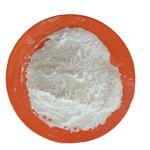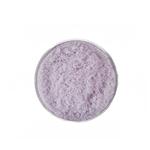Iron(III) nitrate is used as a mordant for dyeing black and buff. Other applications are in tanning; weighting silks; and in preparation of analytical standards, as a fertilizer and food additive.
Iron(III) nitrate is prepared by the action of nitric acid on iron filings or iron oxide followed by crystallization:
2Fe + 6HNO3 → 2Fe(NO3)3 + 3H2
Fe2O3 + 6HNO3 → 2Fe(NO3)3 + 3H2O
Ferric nitrate is a pale violet, green, or grayish-white, odorless solid in lumpy crystals (like salt).Molecular weight = 241.88; Boiling point = decomposes;Freezing/Melting point = 35 C; 47 C (nonhydrate). Hazard Identification (based on NFPA-704 M Rating System):Health 2, Flammability 1, Reactivity 3, Oxidizer. Highlysoluble in water.
Violet crystals. Soluble in water and alcohol.
Ferric nitrate is a pale violet, green, or
grayish-white, odorless solid in lumpy crystals (like salt).
The nonahydrate form occurs as grayish-violet crystal; density 1.68 g/cm3; hygroscopic; decomposes at 47°C; very soluble in water, alcohol and acetone.
Dyeing (mordant for buffs and blacks), tanning,
analytical chemistry.
A violet crystalline solid. Noncombustible but Ferric nitrate will accelerate the burning of combustible materials. If large quantities are involved in the fire or the combustible material is finely divided an explosion may result. Prolonged exposure of the material to fire or heat may result in an explosion. Toxic oxides of nitrogen are produced in fires involving Ferric nitrate. Ferric nitrate is used for dyeing and tanning, in chemical analysis, and in medicine.It is a strong oxidant and irritant,and a fire hazard when in contact with organic substances.
Ferric nitrate is an oxidizing agent. Mixtures with alkyl esters may explode, owing to the formation of alkyl nitrates. Mixtures with phosphorus, tin(II) chloride or other reducing agents may react explosively [Bretherick, 1979 p. 108-109].
Dangerous fire risk in contact with organic
materials. Strong oxidant and irritant.
Inhalation of dust irritates nose and throat. Ingestion causes irritation of mouth and stomach. Dust irritates eyes and can irritate skin on prolonged contact.
Mutation data reported.A reactive oxidizer.
Ferric nitrate is used in textile dyeing,
tanning, and weighting silk.
If this chemical gets into the eyes, remove anycontact lenses at once and irrigate immediately for at least15 min, occasionally lifting upper and lower lids. Seek medical attention immediately. If this chemical contactsthe skin, remove contaminated clothing and wash immediately with soap and water. Seek medical attention immediately. If this chemical has been inhaled, remove fromexposure, begin rescue breathing (using universal precautions, including resuscitation mask) if breathing hasstopped and CPR if heart action has stopped. Transferpromptly to a medical facility. When this chemical hasbeen swallowed, get medical attention. Give large quantities of water and induce vomiting. Do not make an unconscious person vomit. The symptoms of metal fume fevermay be delayed for 4-12 h following exposure: it may lastless than 36 h.Note to physician: For severe poisoning do not use BAL[British Anti-Lewisite, dimercaprol, dithiopropanol(C3H8OS2)] as it is contraindicated or ineffective in poisoning from iron.
Color Code—Yellow: Reactive Hazard; Store in alocation separate from other materials, especially flammables and combustibles. Prior to working with this chemical you should be trained on its proper handling andstorage. Store in tightly closed containers in a cool, wellventilated area away from organic materials and other combustible materials or aluminum powder. See OSHAStandard 1910.104 and NFPA 43A Code for the Storage ofLiquid and Solid Oxidizers for detailed handling and storageregulations.
UN1466 Ferric nitrate, Hazard Class: 5.1;
Labels: 5.1-Oxidizer.
An oxidizer. Keep away from reducing
agents, oxidizable materials and combustibles including
metal powders, sulfur, and organic materials, combustibles,and easily oxidizable materials. Light sensitive. Aqueous
solution is corrosive to metals.



